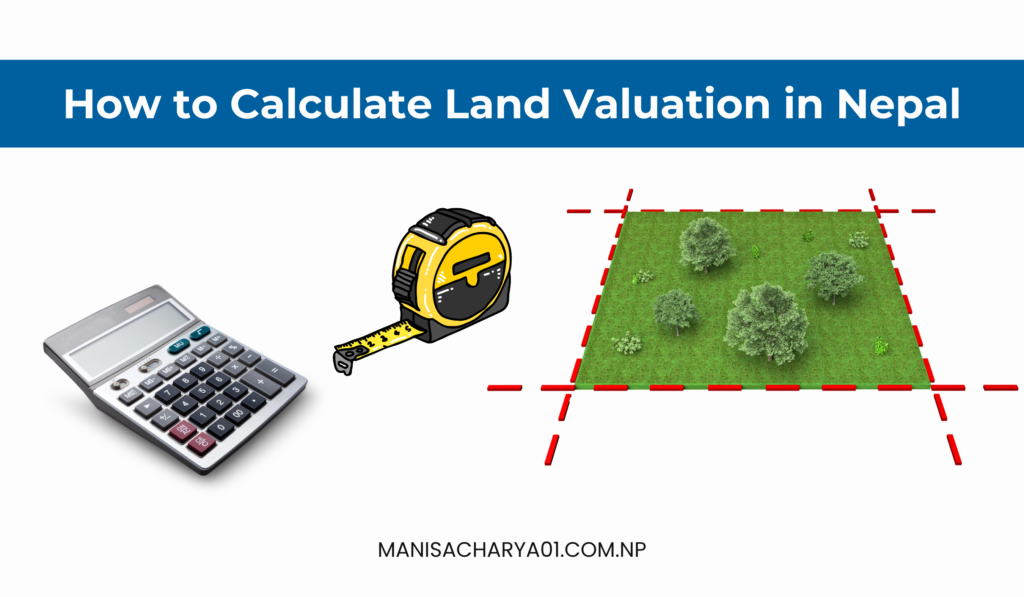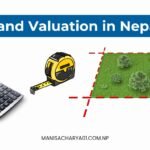How to Calculate land valuation in Nepal involves a combination of government guidelines, market trends, and specific factors related to the land itself. The process can vary depending on the purpose of valuation (e.g., taxation, sale, compensation, or mortgage). Below is a step-by-step guide to understanding how land valuation is calculated in Nepal:
Table of Contents
How to Calculate land valuation in Nepal
Here it:
Understand the Purpose of Valuation
The purpose of land valuation determines the approach and methodology used. Common purposes include:
- Taxation: For property tax calculation.
- Sale/Purchase: For determining market value during transactions.
- Compensation: For government acquisition of land for public projects.
- Mortgage: For securing loans from banks or financial institutions.
Determine the Zonal Value
The Government of Nepal divides land into zones based on location, infrastructure, and development potential. Each zone has a base value (per unit area) assigned by the government. This value is used as a reference for taxation and other official purposes.
- Steps to find zonal value:
- Visit the local Land Revenue Office or the Department of Land Management and Archive (DoLMA).
- Provide the location details (ward number, district, and municipality) of the land.
- Obtain the base value per unit area (e.g., per square meter or per aana) for the specific zone.
Consider Land Characteristics
The value of land is influenced by its physical and legal characteristics. Key factors include:
- Location: Proximity to roads, markets, schools, hospitals, and other amenities.
- Size and Shape: Larger plots or regularly shaped plots may have higher values.
- Topography: Flat land is generally more valuable than sloped or uneven land.
- Land Use: Agricultural, residential, commercial, or industrial land has different values.
- Accessibility: Easy access to transportation and infrastructure increases value.
- Legal Status: Clear ownership and proper documentation add to the land’s value.
Adjust for Market Trends
The zonal value provided by the government is often outdated and may not reflect current market prices. To estimate the market value:
- Consult Real Estate Agents: They have up-to-date information on land prices in the area.
- Compare Recent Sales: Look at recent transactions of similar land in the same area.
- Consider Demand and Supply: High demand for land in urban areas can significantly increase its value.
Check out Land Valuation in Nepal
Use Valuation Formulas
While there is no single formula for land valuation in Nepal, the following methods are commonly used:
a. Government Zonal Value Method
For taxation or official purposes, the government uses the zonal value as the base rate. The formula is: Land Value = Area of Land × Zonal Base Value Land Value=Area of Land×Zonal Base Value
For example, if the zonal value is NPR 10,000 per square meter and the land area is 500 square meters:Land Value=500 sq.m.×10,000 NPR/sq.m.=5,000,000 NPRLand Value=500sq.m.×10,000NPR/sq.m.=5,000,000NPR
b. Market-Based Valuation
For private transactions, the market value is often higher than the zonal value. The formula is:Land Value=Area of Land×Market Rate per Unit AreaLand Value=Area of Land×Market Rate per Unit Area
For example, if the market rate is NPR 20,000 per square meter and the land area is 500 square meters:Land Value=500 sq.m.×20,000 NPR/sq.m.=10,000,000 NPRLand Value=500sq.m.×20,000NPR/sq.m.=10,000,000NPR
c. Agricultural Land Valuation
For agricultural land, the value is often based on productivity and soil quality. The formula is:Land Value=Area of Land×Productivity RateLand Value=Area of Land×Productivity Rate
The productivity rate is determined by local authorities and may vary by region.
Adjust for Additional Factors
Certain factors can increase or decrease the land value:
- Infrastructure Development: New roads, electricity, or water supply can increase value.
- Legal Disputes: Land with ownership disputes or unclear titles may have a lower value.
- Environmental Risks: Land in flood-prone or landslide-prone areas may be valued lower.
Hire a Professional Valuer
For accurate and reliable valuation, it is advisable to hire a professional land valuer or surveyor. They use advanced tools and methodologies to assess the land’s value, considering all relevant factors.
Government Valuation for Compensation
If the land is being acquired by the government for public projects, the valuation is based on the Land Acquisition Act. The government determines the compensation amount, which is often lower than the market value. Landowners can negotiate or appeal if they feel the valuation is unfair.
Documentation and Registration
Once the land value is determined, ensure that all transactions are properly documented and registered with the local Land Revenue Office. This includes:
- Sale Deed: A legal document transferring ownership.
- Tax Payment: Payment of capital gains tax and other applicable taxes.
- Land Registration: Updating the land records with the new ownership details.
Example Calculation
Let’s assume you want to calculate the value of a 500-square-meter plot in Kathmandu:
- Zonal Value: NPR 15,000 per square meter (as per government records).
- Market Value: NPR 25,000 per square meter (based on recent sales in the area).
- Land Value (Zonal): 500×15,000=7,500,000 NPR500×15,000=7,500,000NPR.
- Land Value (Market): 500×25,000=12,500,000 NPR500×25,000=12,500,000NPR.
For taxation purposes, the zonal value (NPR 7.5 million) would be used, while for sale/purchase, the market value (NPR 12.5 million) would apply.
Conclusion
Land valuation in Nepal is a multi-step process that involves understanding government zonal values, market trends, and land-specific factors. While the government provides a baseline for valuation, market rates often differ significantly. For accurate valuation, especially in high-stakes transactions, consulting professionals and staying updated on market trends is essential.
As Nepal continues to urbanize and develop, improving the land valuation system will be crucial for ensuring transparency and fairness in land-related transactions.


